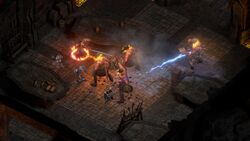Dead State Design Update
Dead State Design Update
Development Info - posted by VentilatorOfDoom on Tue 22 February 2011, 10:30:32
Tags: Dead State; DoubleBear ProductionsI didn't post a design update for DoubleBear's zombie game Dead State for a while, so here is one:
Honestly speaking - I think the second Brian and I decided where we were going to set the game in the US, we settled on a school as the player's Shelter. It wasn't really something we hemmed and hawed about, because it seemed a natural choice to us: as we mentioned in our grand reveal article in Rock, Paper, Shotgun, modern American schools (such as the ones Brian and I went to in Florida and Arizona, respectively) look a lot more like fortresses or prisons than the traditional concept of a school. The esteemed Vince was even a little curious about our choice, but when we sent him pictures of schools we'd found while researching the area, and detailed the various features of our own alma maters, he was stunned at the high levels of security of modern schools, and agreed that a school did indeed seem like a pretty good choice.
Another consideration we had that made the school a good solution is that in many areas of the United States, they're set as designated gathering areas in case of disasters. Their gyms are an excellent place to hold and house displaced residents, they have cooking facilities and basic medical supplies on hand, and while old schools (no joke) had bomb shelters, many newer ones - such as those in the tornado-struck region of Texas where Dead State is set - have underground severe weather shelters. Even if the area was evacuated, those residents either not willing or able to leave would justifiably gather in such a secure location.
The last element that made a school the most feasible location for the Shelter is its modularity. Classrooms are designed to change and swap out elements as teachers and students change, so an unused room has a larger potential to be converted to something more useful than, say, a hotel room could. In addition to this, a school has the starter materials to open up many options for upgrades. The kiln in the art room may not be tested for extremely high temperatures, but with the right supplies and know-how, it might be able to make valuable items. The infirmary is only stocked with the bare minimum of medical supplies, but their advantages are a surplus of room, beds, and an efficient layout. Lab rooms are tested for far higher volume of toxic safety than the average high school chemistry class could ever think of studying - with the right materials, it could prove very useful to you and your fellow survivors. Possibilities exist that require only the right knowledge, supplies, and construction time to unlock, and though you may not have the ability to obtain them all, each one offers its own unique advantages... and, of course, your fellow survivors will have their own preferences for which upgrade to pursue.
Spotted at: ITS
Honestly speaking - I think the second Brian and I decided where we were going to set the game in the US, we settled on a school as the player's Shelter. It wasn't really something we hemmed and hawed about, because it seemed a natural choice to us: as we mentioned in our grand reveal article in Rock, Paper, Shotgun, modern American schools (such as the ones Brian and I went to in Florida and Arizona, respectively) look a lot more like fortresses or prisons than the traditional concept of a school. The esteemed Vince was even a little curious about our choice, but when we sent him pictures of schools we'd found while researching the area, and detailed the various features of our own alma maters, he was stunned at the high levels of security of modern schools, and agreed that a school did indeed seem like a pretty good choice.
Another consideration we had that made the school a good solution is that in many areas of the United States, they're set as designated gathering areas in case of disasters. Their gyms are an excellent place to hold and house displaced residents, they have cooking facilities and basic medical supplies on hand, and while old schools (no joke) had bomb shelters, many newer ones - such as those in the tornado-struck region of Texas where Dead State is set - have underground severe weather shelters. Even if the area was evacuated, those residents either not willing or able to leave would justifiably gather in such a secure location.
The last element that made a school the most feasible location for the Shelter is its modularity. Classrooms are designed to change and swap out elements as teachers and students change, so an unused room has a larger potential to be converted to something more useful than, say, a hotel room could. In addition to this, a school has the starter materials to open up many options for upgrades. The kiln in the art room may not be tested for extremely high temperatures, but with the right supplies and know-how, it might be able to make valuable items. The infirmary is only stocked with the bare minimum of medical supplies, but their advantages are a surplus of room, beds, and an efficient layout. Lab rooms are tested for far higher volume of toxic safety than the average high school chemistry class could ever think of studying - with the right materials, it could prove very useful to you and your fellow survivors. Possibilities exist that require only the right knowledge, supplies, and construction time to unlock, and though you may not have the ability to obtain them all, each one offers its own unique advantages... and, of course, your fellow survivors will have their own preferences for which upgrade to pursue.
Spotted at: ITS














